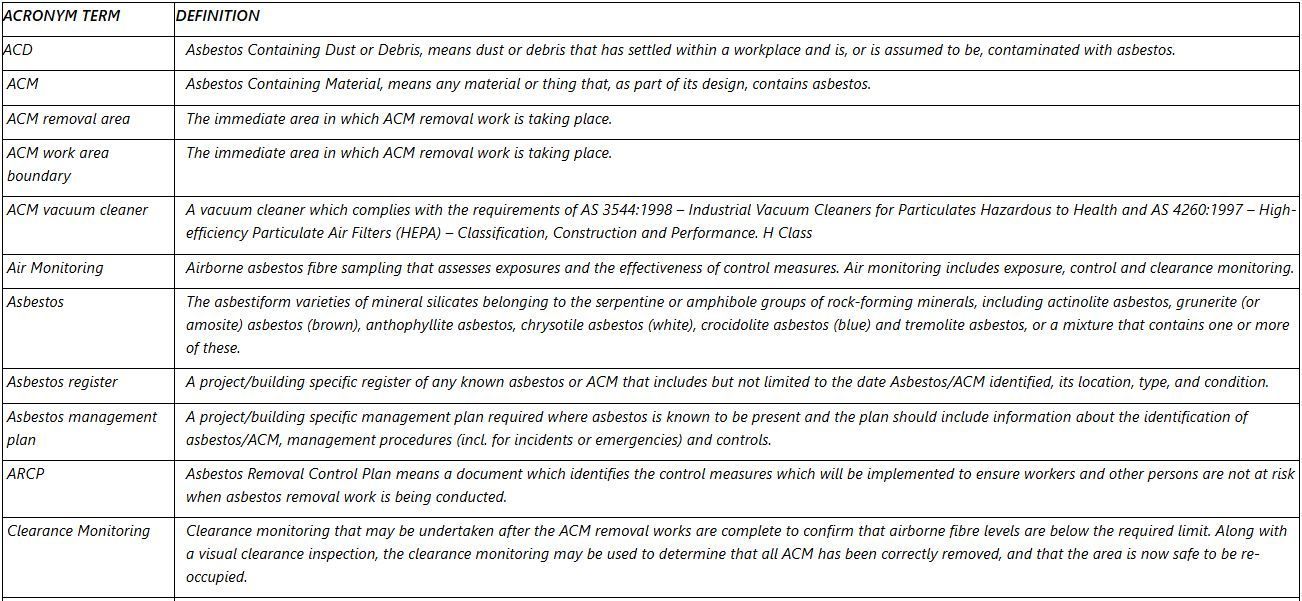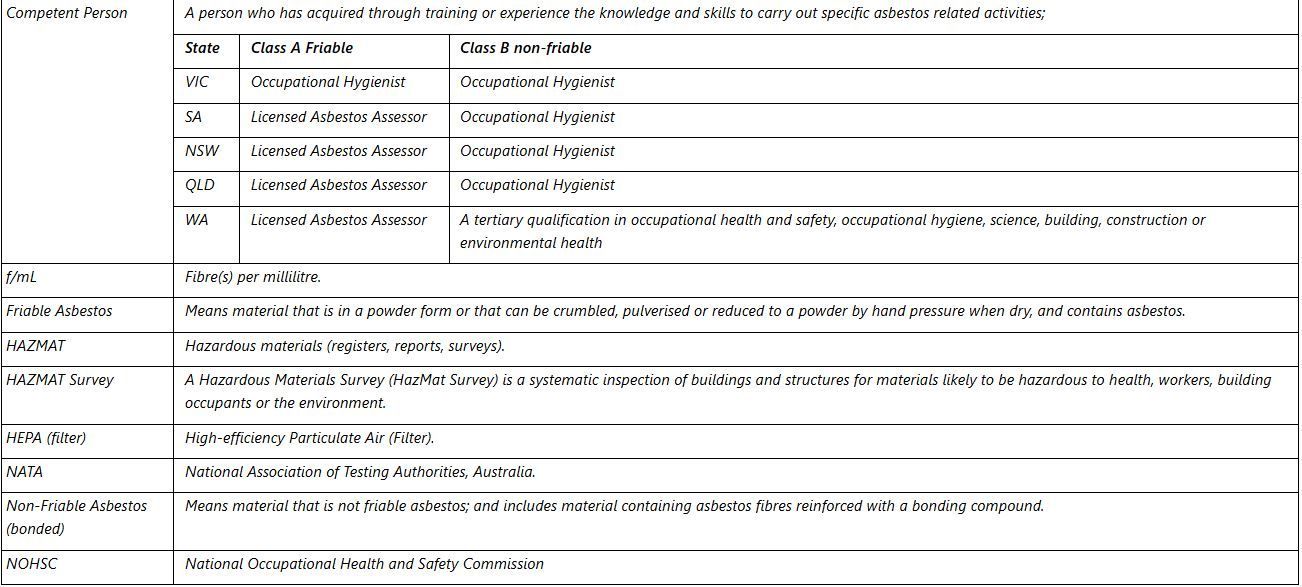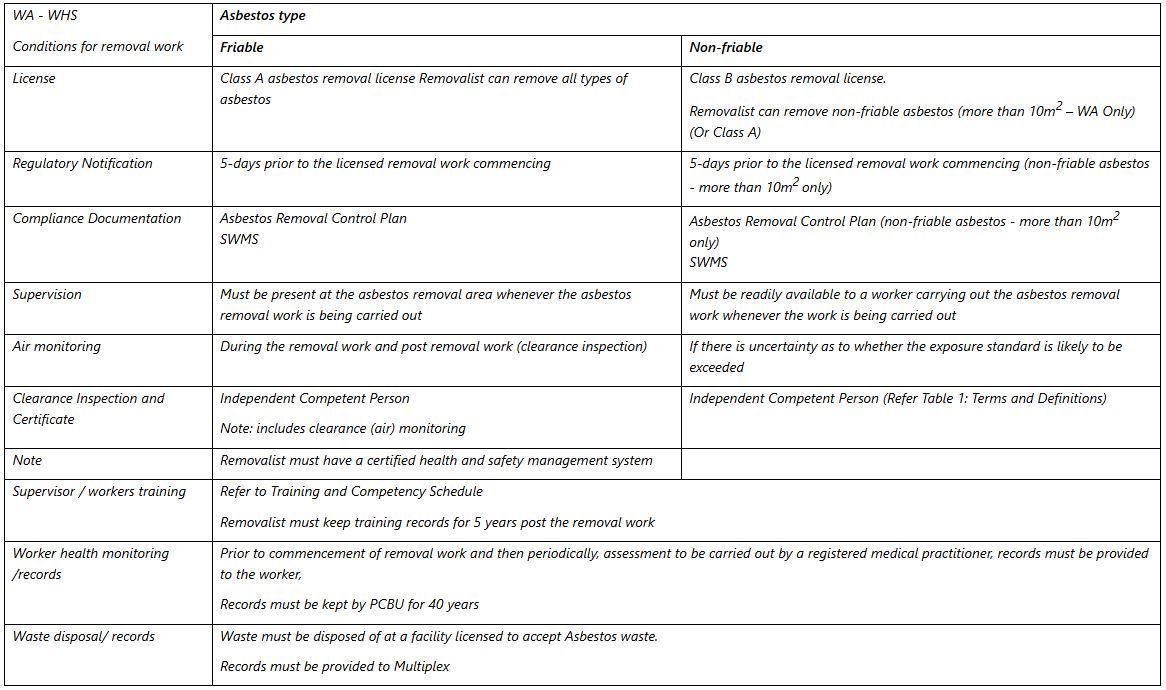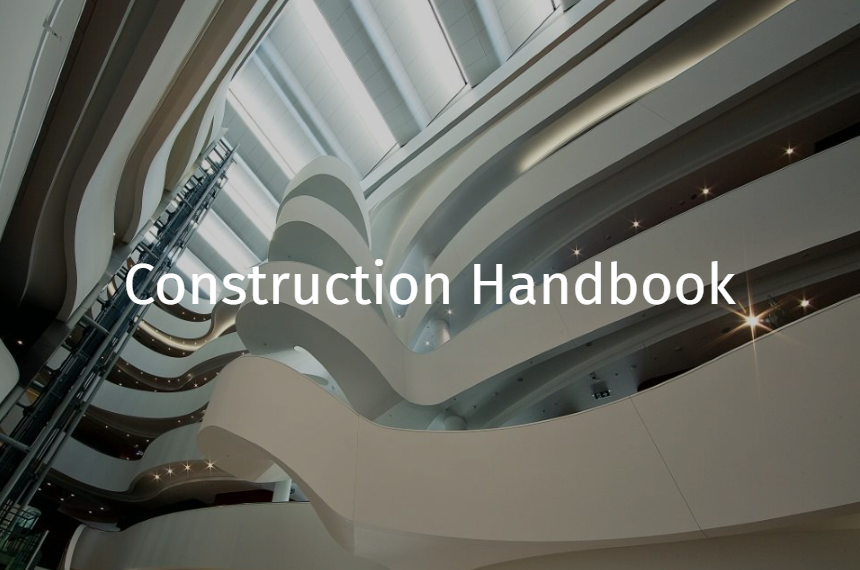Asbestos Containing Materials - General
References: R Record keeping requirement | E An engineering/certification requirement | P A permit to work requirement | S A safe work method statement (SWMS) / written plan
Potential Hazards
Potential hazards include, but are not limited to:
- Asbestos
Table 1: Terms and definitions


Click here to view:
FIGURE 1 – NSW. QLD, VIC overview - Flowchart of the management of ACM
Note: Multiplex’s AA only applies to NSW
Click here to view:
FIGURE 2 – VIC - Flowchart on who can perform asbestos work
Click here to view:
FIGURE 3 – VIC - Flowchart on the General Principles of Asbestos Management
Click here to view:
FIGURE 4 – VIC - Flowchart on the asbestos register duties
Table 2: Asbestos (ACM/ACD) removal work compliance requirements - overview

Planning
Identification of ACM
As far as reasonably practicable and before the commencement of any refurbishment, demolition or excavation at historical sites, the potential for ACM must be investigated by reviewing existing:
- R Asbestos management plan/register and or hazardous materials registers/reports/surveys/reports (HAZMAT)
- R Geotechnical reports.
Further Investigation
Where information exists that identifies the presence / potential presence of ACM, further investigation may be required, this can include, but is not limited to:
- R Additional HAZMAT survey(s) (e.g. Intrusive / destructive) and
- R Additional geotechnical survey(s) where applicable (NATA approved sampling methods should be used).
- R Additional asbestos in soil investigations
NATA approved sampling methods should be used.
Where site activities require demolition to parts or all of an existing building, then the building owner must provide their existing (current) asbestos management plan / register / HAZMAT report. Where information is not available from the building owner, then prior to or in conjunction with the commencement of demolition or refurbishment work Multiplex shall commission a Hygienist/licensed assessor to complete an intrusive HAZMAT survey and summarise findings in a HAZMAT survey report.
WA – Note: An intrusive HAZMAT survey may also be known as a demolition or refurbishment survey.
VIC - Note: Asbestos and Hazardous Materials Division 6 audit of the property
If there is uncertainty over the accuracy of an existing HAZMAT survey report. Multiplex may commission a separate HAZMAT survey and report including intrusive / destructive testing.
Any material assumed to be ACM must be treated as ACM until verified by a Competent Person as not ACM.
R Any HAZMAT registers/reports/survey’s findings should be compiled into one register. The register must include the following information:
- Date ACM identified
- Location of ACM to be marked on a project map, referenced to building grid line
- Validation of ACM type (friable or nonfriable) including confirmatory testing through laboratory analysis
- Photograph(s) of identified ACM
- Activity being undertaken at the time of identification
- Licensed contractor who removed ACM
- Actions taken during removal
- Validation of ACM clearance (post removal) to be confirmed by laboratory analysis and
- Records of waste receipts for ACM disposal to a licensed facility.
Communication and Consultation
Where ACM has been identified during the planning stages and is still present on a project, the following information must be made available via appropriate communication e.g. site induction, signage, toolbox talk:
- Details of any areas of the project in which there is known ACM
- The notification procedure as described by ‘Unexpected ACM Finds’
- Reference to this procedure and any HAZMAT survey report / Asbestos management plan / register with copies made available to workers upon request.
Documents and Forms
Australia
- HAZMAT survey & report
- Asbestos management plan - project
- Asbestos register - project
- Detailed Site Investigation report
- Clearance report
- Asbestos Removal Control Plan
- SWMS
Western Australia
- Haz. Materials & Unexpected Finds Register WA HSE INC REG 950.
Other Publications
- SafeWork Australia - Health Monitoring for Exposure to Hazardous Chemicals - Guide for Medical Practitioners
- SafeWork Australia - Hazardous Chemicals Requiring Health Monitoring
- Safe Work Australia – Workplace Exposure Standards for Airborne Contaminants
Legal and Other Requirements
- Health (Asbestos) Regulations 1994
- Safe Removal of Asbestos 2nd Edition [NOHSC:2002 (2005)
- Management and Control of Asbestos in Workplaces [NOSHC: 2018 (2005)]
- Control of Workplace Hazardous Substances [NOSHC:2007 (1994)]
- AS3544:1998 – Industrial Vacuum Cleaners for Particulates Hazardous to Health
- AS4260:1997 – High-efficiency Particulate Air Filters (HEPA) – Classification, Construction and Performance
- Landfill Waste Classifications and Waste Definitions’ – classified as a Special Waste (Type 1)
- Guidelines for Health Surveillance [NOSHC: 7039 (1995)]
- How to Manage & Control Asbestos in the Workplace Code of Practice (Qld) 2011
- How to Safely Remove Asbestos Code of Practice (Qld) 2011
- How to Safely Remove Asbestos Code of Practice (WA) 2022
- How to Manage & Control Asbestos in the Workplace Code of Practice (WA) 2022
Document Control
Version 1 August 2019 – New Procedure
Version 2 August 2025 –
- Updated to incorporate WA legislative changes.
- Revised definitions, investigation procedures, and communication and consultation requirements.
- Additional flowcharts specific to VIC, table outlining asbestos removal compliance requirements and references to relevant codes of practice.







